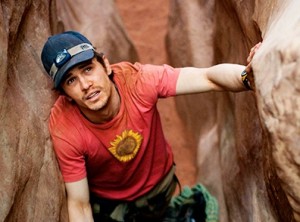By Alec Lautenan
Theme Editor
At first thought, it doesn’t seem as if a film with only one character (and an immobile one at that) would be enthralling. But Danny Boyle’s “127 Hours,” starring James Franco as outdoorsman Aron Ralston, defies this completely with a brilliant and empowering story of human survival.

Described by Boyle as “an action movie with a guy who can’t move,” “127 Hours” masterfully carries audiences through Ralston’s ordeal; he is pinned underneath a rock in a desolate canyon with minimal supplies. It does this though a combination of intuitive direction by Boyle and expert acting on Franco’s part, creating a praise-worthy testament to the human spirit and one man’s will to live.
Based on Ralston’s autobiography “Between a Rock and a Hard Place,” “127 Hours” comes after Slumdog Millionaire for Boyle, another film pitting a protagonist against insurmountable odds. Boyle had expressed desire to direct the film four years prior to its release and collaborated with Simon Beaufoy in writing the screenplay.
Boyle proves to be a master of suspense. The director manages to cut between Ralston’s experiences and hallucinations convincingly throughout his entrapment in Blue John Canyon. The movie culminates in the protagonist’s infamous self-amputation scene, and Boyle spares no gruesome detail or image.
Boyle’s direction also manages to artfully pair Ralston’s entrapment with scenes of his reflections on life and childhood. Boyle makes good use of Ralston’s daily video journal he recorded while in the canyon, which actually provides some of the most humorous and enlightening moments in the film. Boyle and cinematographers Enrique Chediak and Anthony Dod Mantle also made efficient use of the limited space in the canyon, creating unique and varied angles that keep the film interesting.
But all of this would have been useless without Franco’s captivating performance. His transition from an independent and over-confident outdoorsman to a helpless and stranded individual is seamless. Franco grippingly portrays Ralston’s incredible sense of determination, but the subtleties of his performance make the film. Franco’s tiny celebrations after gathering the strength to pick up a dropped knife or refill his water bottle are sensational.
Franco is also able to convey this same satisfaction with his character’s most grueling task: the amputation. He’s swept with happiness once he realizes that he has found a viable means of freeing himself.The most prominent of these moments is immediately after he frees himself. Franco looks back at the boulder, cracks a smile and snaps a picture.
Both Boyle and Franco never fail to hold attention through the entire film and a simplistic yet amazing product is produced. The combined efforts of these two give an incredible realization to Ralston’s story.
“127 Hours” is rated R and is currently playing at ArcLight Beach Cities.


Leave a Reply